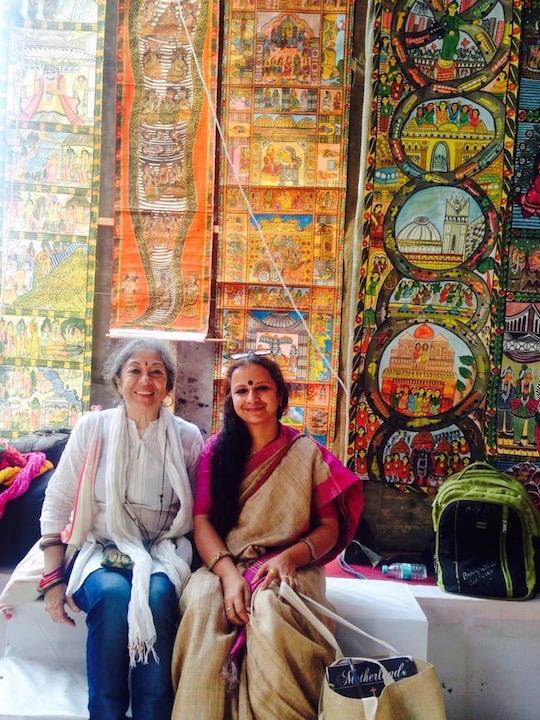PERFORMING TRANSFORMATION
Written by: Lubna Marium
Posted on: Monday 4th of April 2016 12:51:13 PM

Reflections on SASIAN JOURNEYS, A Folk-life Fest
My article in the April 2016 issue of SEMINAR (http://www.india-seminar.com/semframe.html) The Lotus Bazaar and Sasian Journeys workshop, held in March 2015 in Delhi, opened with a performance by the charismatic and multi-talented performer Madan Gopal Singh singing paeans extolling the plurality inherent within South Asia. This set the tone for many such presentations including the Muslim Mangnyars from Rajasthan evoking Hindu Gods and Goddesses, the Bauls and Fakirs of Birbhum integrating tantric and Sufi traditions, and more Muslim patuas, or folk scroll-painters from Bengal, presenting the Ramayana and the Mahabharata. Very aptly, the 3-day event highlighted the assimilative nature of performative traditions within almost every region of South Asia. And, why not? For centuries South Asia has believed that performance is a ‘site for transformation’. In the 10th century Abhinavagupta, (c. 950 – 1020 AD) one of India’s greatest philosophers, mystic and aesthetician, writes ‘ Tasmādanuvyavasay ātmakam kīrtaṇam ruṣita vikalpa samvedanam nātyam ’ (Abhinavabharati). Roughly translated it states that performance is a ‘narration’ (kirtanam), conceived by a re-perception - ‘consciousness affected by discursive cognitions’ (Gnoli, Raniero; ‘The Aesthetic Experience According to Abhinavagupta’; 1956) - that evokes a different way of seeing reality. This definition of performance makes two important statements. Firstly, theatre is not an imitation of reality, it is a reorganization (anuvyavasaya atmakam ), or transformation, of our lived experiences through an active apperception, or voluntary consciousness merging within self-consciousness. In affect a deconstruction of the world, as we know it, followed by a conscious reconstruction. Secondly the stage is a site for an alternate mode of cognizing (vikalpasamvedanam) reality. By witnessing alternative perspectives presented through persuasive performances the audience is gripped with the desire to change. The stage, or performance space, is able to achieve, this transformation because it is recognized as an ‘alaukika’, or extra-empirical, space. Unlike real life, actions on stage are neither subjective, nor are they objective. They are beyond the mundane and are extra-daily. Here actions have no ‘arthakriya karitva’ (causal efficiency), or purposivity, but to evoke inner consciousness. Therefore, the stage is a liminal, or ambiguous space, where normative structures of power are broken down and the actor is empowered to play out her role to assert various notions. These include radical notions of ‘self’, of religion et al. Similar to a ‘ritual’, during the liminal stage of a performance, participants stand at the ‘’threshold " (Victor Turner; ‘The Ritual Process: Structure and Anti-Structure’; 1995) between their previous way of structuring their identity, time, or community, and a new way, which the performance establishes. In this 'otherworldly' and magical space it is easy to transform and become whatever one wants to. Therefore, very easily the Muslim scroll-painter Pir Baksh takes on the stage persona of Prakash Chitrakar; Nojrul Islam's mother in Horipur, in Bangladesh, walks on to this enchanted threshold to offer prayers to the Hindu Goddess Manasa during her pledged performance of 'Manasa Mangal'; and yet again Feroze Khan Mangnyar, in the village of Hamira in Rajasthan, sings in praise of Krishna. For centuries belief systems have been acted and reenacted through radical performances urging people towards transformation and change. As early as the 6th Century AD we come upon the Buddhist Charyapada songs, utilizing 'sandhyabhas' or 'twilight language' to put across the ideals of Vajrayana beliefs. This tradition of 'singing out beliefs' is carried on by, amongst others, the poems of the 13th century Kashmiri saint Lalleshwari, the 15th century mystic saint Kabir, and continue into present times with lyrical debates on religion performed in the Kobi-gaan of Bangladesh. The other way in which South Asia has empowered performance is by recognizing it as 'sarvavarnika' - owned by all castes, making it non-hierarchical. This immediately gives it an edge over other external forces and 'shrines of power, and in particular, with the forces that hold the keys to those shrines' (Ng?g? wa Thiong'o; 'Enactments of Power: The Politics of Performance Space'; 1997). It is within the performance space that bonds are forged that are open, giving, non-hierarchical, and inclusive. It is here that 'idea' win over 'power' and 'capital'. Furthermore, performance space being 'anti-structure', it looks beyond traditions and is assimilative, hence encouraging hybridity. Hybridity is most commonly used to describe conditions where different cultures connect, merge, intersect and eventually transform (Spielmann & Bolter, 2006). In the early 1900s Rabindranath Tagore experimented with music from all over the world and brought them together in his matchless creations. Finally, performance looks beyond the 'present'. It is radical and dares to imagine a new reality. It has often been commented that what the stage, the poet, the creative actor dares to imagine, could very well one-day become reality. South Asia, with its exciting performative traditions, has always encouraged these notions.
Leave a Comment:
Read what others says about us
- documenting for posterity
- performing transformation
- cherishing tradition
- the body speaks anew
- in conversation with two shadhona dancers
- gidree bawlee: empowerment through art
- in conversation with shadhona dancer sinthia yasmin nupur
- don’t hold your breath!
- #freetagore
- history of rhythm, in pixels
- of monsoons, myths and manasa
- culture: the present site for struggle
- the art & politics of documentation
- and, theatre strikes back!
- lest we forget: atiśa
- dancing away boundaries
- dance-why?
- haha
- hhh
- heked
Advertisement #1

Advertisement #2

Advertisement #3
